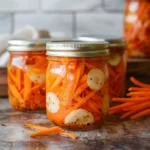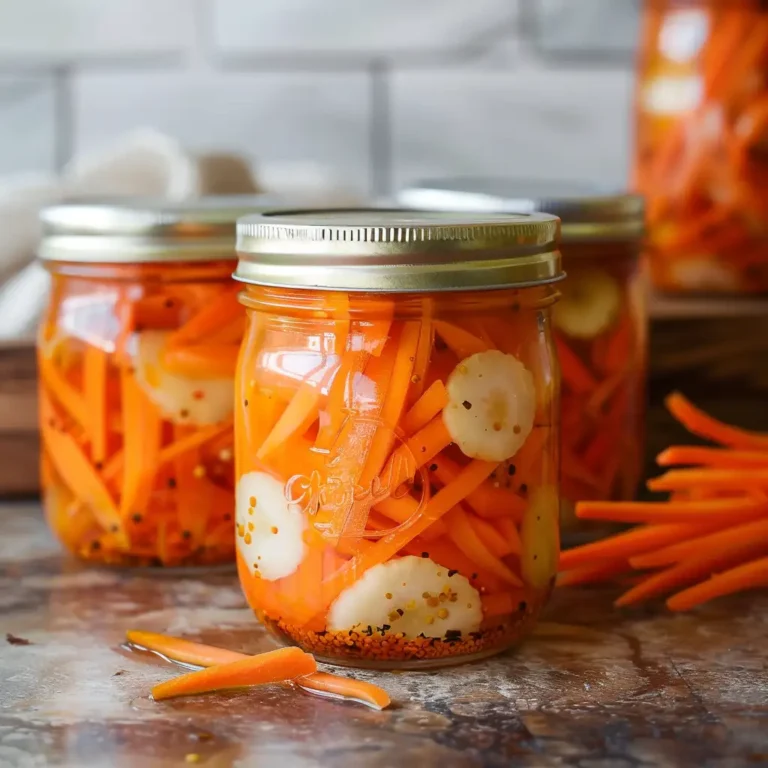Introduction
Pickled carrots are a delicious and versatile addition to any meal, offering a delightful crunch and a burst of flavor. Pickling is an age-old preservation method that has gained immense popularity due to its ability to enhance the taste and shelf life of vegetables. In this article, we will delve into the fascinating world of pickled carrots, exploring their history, health benefits, and the various ways they can be enjoyed. Whether you are a seasoned pickling enthusiast or a curious beginner, this guide will provide you with all the information you need to make and enjoy your own pickled carrots.
History and Origin of Pickling
Pickling is one of the oldest preservation techniques, dating back thousands of years. Ancient civilizations used pickling to extend the shelf life of perishable foods, ensuring a stable food supply during times of scarcity. The cultural significance of pickling can be seen in various cuisines around the world, from the spicy kimchi of Korea to the tangy sauerkraut of Germany.
As pickling methods evolved, so did the variety of ingredients and techniques used. Today, pickling has become a popular culinary practice, celebrated for its ability to enhance flavors and introduce unique taste profiles to everyday foods
Health Benefits of Pickled Carrots
Pickled carrots are not only tasty but also offer numerous health benefits. They are a rich source of vitamins and minerals, including vitamin A, vitamin K, and potassium. Additionally, the fermentation process involved in pickling introduces beneficial probiotics, which are essential for maintaining a healthy gut microbiome.
Probiotics found in fermented pickles can aid in digestion, boost the immune system, and improve overall gut health. Moreover, pickled carrots are a low-calorie snack option, making them an excellent choice for those looking to maintain or lose weight.
Ingredients:
- 1 lb carrots, peeled and sliced into sticks
- 1 cup white vinegar
- 1 cup water
- 1/4 cup sugar
- 2 teaspoons salt
- 1 teaspoon mustard seeds
- 1 teaspoon whole peppercorns
- 2 cloves garlic, smashed
- 2 sprigs fresh dill
- 1/2 teaspoon red pepper flakes (optional)
Directions:
- Prepare the Brine:
- In a saucepan, combine water, vinegar, sugar, salt, mustard seeds, peppercorns, garlic, and red pepper flakes (if using).
- Bring to a boil, stirring until the sugar and salt dissolve.
- Remove from heat and let cool slightly.
- Pack the Jars:
- Pack carrot sticks, fresh dill, and garlic cloves into clean jars.
- Add the Brine:
- Pour the warm brine over the carrots, ensuring they are fully submerged.
- Tap jars gently to release any air bubbles.
- Seal and Refrigerate:
- Seal jars with lids and refrigerate for at least 24 hours before serving.
Creative Recipes Using Pickled Carrots
Pickled carrots can be used in a variety of creative recipes that enhance the flavors of salads, sandwiches, and main dishes:
Salads
- Asian-Inspired Salad: Toss pickled carrots with mixed greens, sesame seeds, and a soy-ginger dressing for a refreshing salad.
- Mediterranean Salad: Combine pickled carrots with cucumbers, tomatoes, feta cheese, and olives for a tangy twist on a classic Greek salad.
Sandwiches and Wraps
- Banh Mi Sandwich: Add pickled carrots to a Vietnamese Banh Mi sandwich along with cucumbers, cilantro, and spicy mayo.
- Veggie Wrap: Include pickled carrots in a wrap with hummus, spinach, and avocado for a crunchy texture and zesty flavor.
Main Dishes and Side Dishes
- Stir-Fries: Incorporate pickled carrots into stir-fries for an extra layer of flavor.
- Taco Toppings: Use pickled carrots as a topping for tacos to add a bright and tangy element.
Storage and Shelf Life
Proper storage is essential to ensure the longevity and quality of pickled carrots. Here are some tips for storing your pickles:
- Refrigeration: Store pickled carrots in an airtight container in the refrigerator. This will keep them fresh and crisp.
- Shelf Life: Pickled carrots typically last for several weeks to a few months in the refrigerator. Be sure to check for any signs of spoilage before consuming.
Signs of Spoilage
- Mold: If you see mold growing on the surface, discard the pickles immediately.
- Off Smell: An unpleasant or sour smell (beyond the normal pickling scent) is a sign that the pickles have spoiled.
- Texture Changes: If the carrots become too soft or slimy, it’s best to throw them away.
FAQs
What are the best carrots for pickling?
- Fresh and Firm: Choose fresh, firm carrots without any blemishes for the best results.
- Varieties: Both regular and baby carrots can be used, but make sure they are of high quality.
Can you pickle baby carrots?
- Yes, baby carrots can be pickled and are a convenient option due to their size and uniformity.
How long do you need to wait before eating pickled carrots?
- Quick Pickles: These can be enjoyed after a few hours, but they taste better after a day or two.
- Fermented Pickles: These require a longer waiting period, typically 1-2 weeks, to develop their full flavor.
Can you reuse pickling brine?
- Limited Reuse: While you can reuse pickling brine for a second batch, it may lose some of its potency. It’s generally best to make a fresh brine for optimal flavor.
Are pickled carrots good for weight loss?
- Low-Calorie Snack: Yes, pickled carrots are low in calories and can be a healthy addition to a weight loss diet.
Conclusion
Pickled carrots are a delightful and healthy addition to any diet, offering a range of flavors and textures that can enhance any meal. With a rich history, significant health benefits, and various pickling methods to choose from, there’s no reason not to try making your own pickled carrots at home. Share your experiences and recipes, and enjoy the benefits of this versatile and nutritious snack.
By following this comprehensive guide, you will not only master the art of pickling carrots but also gain a deeper appreciation for this ancient culinary tradition. Happy pickling!
Print
Pickled Carrots Recipe
- Total Time: 24 hours (includes refrigeration time)
- Yield: 2 jars
Description
Pickled carrots are a tangy and crunchy snack that can add flavor to various dishes. This easy recipe allows you to enjoy the nutritional benefits of carrots in a preserved form, perfect for snacking or as a condiment.
Ingredients
- 1 lb carrots, peeled and sliced into sticks
- 1 cup white vinegar
- 1 cup water
- 1/4 cup sugar
- 2 teaspoons salt
- 1 teaspoon mustard seeds
- 1 teaspoon whole peppercorns
- 2 cloves garlic, smashed
- 2 sprigs fresh dill
- 1/2 teaspoon red pepper flakes (optional)
Instructions
- Combine water, vinegar, sugar, salt, mustard seeds, peppercorns, garlic, and red pepper flakes (if using) in a saucepan. Bring to a boil, stirring until sugar and salt dissolve. Remove from heat and let cool slightly.
- Pack carrot sticks, fresh dill, and garlic cloves into clean jars.
- Pour the warm brine over the carrots, ensuring they are fully submerged. Tap jars gently to release any air bubbles.
- Seal jars with lids and refrigerate for at least 24 hours before serving.
Notes
- Adjust the amount of red pepper flakes to control the spiciness.
- Use fresh, firm carrots for the best texture.
- Experiment with other vegetables like cucumbers and radishes using the same brine.
- Prep Time: 15 minutes
- Cook Time: 10 minutes (to boil the brine)
- Category: Snacks, Condiments
- Method: Pickling
- Cuisine: Various
Nutrition
- Calories: Approximately 25
- Sugar: 3g
- Sodium: 300mg
- Fat: 0g
- Carbohydrates: 6g
- Fiber: 1.5g
- Protein: 0.5g

